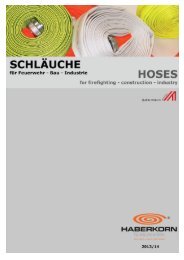Gebrauchsanleitung / pdf - Haberkorn Textiles
Gebrauchsanleitung / pdf - Haberkorn Textiles
Gebrauchsanleitung / pdf - Haberkorn Textiles
You also want an ePaper? Increase the reach of your titles
YUMPU automatically turns print PDFs into web optimized ePapers that Google loves.
Beidbeiniger-Einsatz:- Üben sie die Verwendung in einem gesicherten Umfeld!- Mit beiden Beinen in einer Schlinge!- Die Schlingentaschen werden über den Reißverschluss geöffnet.- Die Entlastungsschlingen aus der Tasche nehmen und frei nach untenhängen lassen.- Versuchen sie Verdrehungen im 20 mm Gurtband zu vermeiden.- Wählen sie die für sie passende Schlingenlänge in dem sie einender beiden Verbindungshacken in eine der Verstellschlaufen desgegenüberliegenden Entlastungsbandes einhängen.- Jetzt können sie mit beiden Füßen in die Schlinge steigen.- Belasten sie die Entlastungsschlinge nur langsam.- Am Anfang hören sie das Geräusch des sich lösenden Klettverschlussesan den beiden Schlingentaschen.- Die Schlinge wird etwas länger, bis die sich aufbauende Spannung auchdie 110 mm Einbindeschlaufen ausspannt.- Durch das durchstrecken der Knie heben sie den Körper aus derBelastung im Auffanggurt heraus.- Somit verringert sich der Druck, den die Beinschlaufen auf derOberschenkelinnenseite erzeugen und die Blutzirkulation in den Beinenist wieder möglich.Einbeiniger-Einsatz:- Üben sie die Verwendung in einem gesicherten Umfeld!- Für jedes Bein eine eigene Schlinge!- Die Schlingentaschen werden über den Reißverschluss geöffnet.- Die Entlastungsschlingen aus der Tasche nehmen und frei nach untenhängen lassen.- Versuchen sie Verdrehungen im 20 mm Gurtband zu vermeiden.- Wählen sie die für sie passende Schlingenlänge in dem sie denVerbindungshacken in eine der fünf Verstellschlaufen des jeweiligen Entlastungsbandes einhängen.- Jetzt können sie mit den Füßen in die einzelnen Schlingen steigen.- Belasten sie die Entlastungsschlingen nur langsam.- Am Anfang hören sie das Geräusch des sich lösenden Klettverschlusses an den Schlingentaschen.- Die Schlingen werden etwas länger, bis die sich aufbauende Spannung auch die 110 mm Einbindeschlaufenausspannt.- Durch das durchstrecken der Knie heben sie den Körper aus der Belastung im Auffanggurt heraus.- Somit verringert sich der Druck, den die Beinschlaufen auf der Oberschenkelinnenseite erzeugen und dieBlutzirkulation in den Beinen ist wieder möglich.2
INSTRUCTIONMANUAL FOR USE OF SUSPENSION TRAUM RELIEF STRAPA. <strong>Haberkorn</strong> & Co. GmbHWerndlstraße 3A-4240 Freistadt, AustriaTel: +43 7942 77177Fax: +43 7942 77180Mail: textil@haberkorn-textiles.atWeb: www.haberkorn-textiles.at4290026Product description:The suspension trauma relief strap is used for the relief of leg strap pressure,on the thigh inner side, after a fall into a full body harness, to prevent the riskof a suspension trauma (orthostatic shock).The two slings can be used together as a common sling and have to beconnected to each other.You can also use them as individual discharge slings for each individual leg.The suspension trauma relief strap is not subject to any standard and mayonly be used for the purpose described above. Any other use is to exclude.Mounting on the full body harness:With the 110 mm long binding loop the discharge sling is mounted on the fullbody harness – connected into the restraint belt, or on harnesses withoutrestraint belt mounted in height of the hip.With the velcro fastener the loop pockets are fixed on the full body harness.The position has to be chosen in such a way, that the function of the harnessremains unaffected.Depending on the design of the harness, the placement of the relief strap onthe right and left side of the restraint belt has to be chosen that way, that in caseof hanging into the harness after a fall, the relief straps can be reached safely.Version:-Black 20 mm wide webbing-Length 175 mm-1 Piece connection hook-5 loops-110 mm long binding strap-weight approx. 46 g3
Operation with both legs:- Practice use in a safe environment!- With both legs in a sling!- The loop bags are opened with the zipper.- Take the relief straps out of the pocket and hang them down freely.- Try to avoid distortions in the 20 mm strap.- Choose the suitable length for the relief straps in that way, that you hangone of two connection hooks into one of the opposite adjustment loops.- Now you can step into the relief straps with both feet.- Please only charge the relief straps slowly.- At the beginning, you will hear the sound of the velcro to be resolvedon the two loop bags.- The relief straps gets slightly longer, until the tension also spans the 110mm long binding strap.- Through the stretching of the knee you will lift out the body from the loadin the full body harness.- Thus the pressure created on the inner side of the thigh of the leg loopswill be decreased and blood flow in the legs, is possible once again.Operation with single leg:- Practice use in a safe environment!- For each leg an own relief strap!- The loop bags are opened with the zipper.- Take the relief straps out of the pocket and hang them down freely.- Try to avoid distortions in the 20 mm strap.- Choose the suitable length for the relief straps in that way, that you hangeach of the two connection hooks back into one of the 5 adjustment loopsof the same strap.- Now you can step into each of the relief straps with each foot.- Please only charge the relief straps slowly.- At the beginning, you will hear the sound of the velcro to be resolved on the two loop bags.- The relief straps gets slightly longer, until the tension also spans the 110 mm long binding strap.- Through the stretching of the knee you will lift out the body from the load in the full body harness.- Thus the pressure created on the inner side of the thigh of the leg loops will be decreased and blood flowin the legs, is possible once again.4





